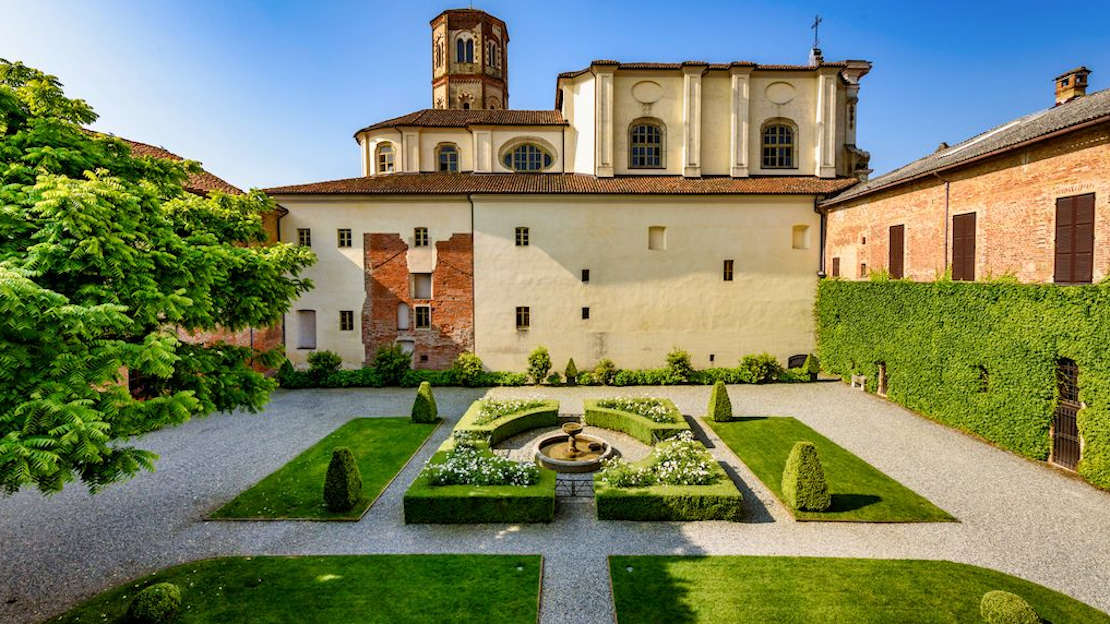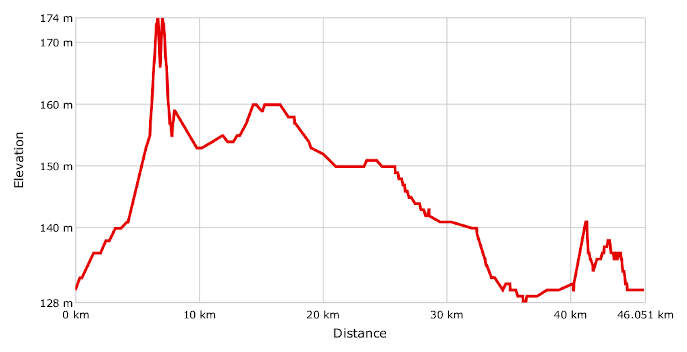
- Bike: trekking
- Difficulty: **
- Distance: 46 km
- Altitude difference: 46 m
- Total ascent: 83 m
- Total descent: 83 m

This route is easy-going and you can make a lot of stops on the way. It's an adventure by bike through stories and legends shrouded in mystery.
Among the evocative places you'll visit on the route are the granges of Lucedio and Darola, the church of Madonna delle Vigne and the hamlet of Saletta.
It starts in Trino, known as Rigomago in Roman times, when it became a mansio, a resting place for the army.
The name Tridinum dates from the sixth century AD according to legend. Rigomago was almost totally destroyed in the bloody barbarian invasions, but rebuilt by three brave Lombard commanders. They erected the defensive walls and three castles. The old walls were pulled down in 1672 on the orders of Charles Emmanuel II of Savoy. The demolition took many years, thanks to the opposition of the townspeople, who feared they would be left unprotected. Today only a short section of wall remains on Via Monte Grappa, near the Palazzo Paleologo on the site of the fort of the marquesses of Monferrato.
For practical reasons, the route begins in Piazza Garibaldi, which has a large car park. From the walls of old Rigomago, head off on your bike in the direction of Borgo Ramezzana, a 19th-century country house that's now a romantic hotel.
You are now between the Bosco delle Sorti della Partecipanza wood and the Palude di San Genuario marshes, which are a Piedmontese regional nature reserve and a special area of conservation within the EU's Natura 2000 network. This is the only nesting site in Piedmont of the bittern, purple heron and marsh harrier.
Make your first stop in Montarolo, at the church of the Madonna delle Vigne, which is deconsecrated, vandalised and in an awful state of repair. Inside is a fresco of an organ, with sheet music above known as the Devil's Score. According to local legend, if you play the notes from the score, you'll keep the demons at bay. Play them backwards, however, and you'll release a demon.
Carry on through villages in the province of Vercelli to Castell’Apertole a little village with a statue of a frog, the animal that symbolises the local rice field habitat. Carry on to the farm La Colombara.
The little cemetery nearby is evocative. It has been abandoned for years now and lies bare, silent and almost forgotten. It's also worth stopping at La Colombara for the Museo delle Mondine. Afterwards, set off along the edge of the former Galileo Ferraris thermal power plant, whose cooling towers you can see. Enter the now abandoned hamlet of Leri Cavour, where the municipal council of Trino have attempted to restore the noble residence of the Benso family of Cavour. It was at the grange of Leri that Camillo Benso, Count of Cavour, spent long periods managing his estate. Today the atmosphere in this little place is one of profound neglect. Leave the ghost village and carry on along tracks to the Principato di Lucedio, a place as fascinating as it is mysterious. Stories and legends of this enchanting place, once home to a Cistercian abbey, tell of demonic possessions, monks subjected to exorcisms and mummified, a seal that imprisoned Satan, and a key for releasing him.
What's certain is that the Cistercians, who were careful planners and great experts on agricultural techniques, reclaimed the wooded and marshy areas around them for orchards. The abbey of Lucedio was founded in 1123, when Marquess Rainier of Monferrato gave some land to the north of Trino to Cistercian monks from La Ferté in France.
From the Principato di Lucedio, set off to the abandoned cemetery of Darola, a haven of peace but also the setting for sinister stories and unfortunate events. Locals regard it as a cursed place. Carry on to the grange of Darola, now a working rice farm.
Head along tracks towards Ronsecco, a village where you can enjoy traditional dishes, from rice panissa to salam d'la duja, a pure pork sausage that is seasoned and kept in glass jars. It is then covered in pig fat, which preserves it and keeps the mixture soft.
Carry on to Tricerro, then Costanzana, where the route continues to the hamlet of Saletta, a famous spot for fans of the occult. On the walls of the church of San Bartolomeo, which has been deconsecrated for years, are carved cow skulls, a mysterious symbol of the demonic cult. The entrance to the church was recently walled off to stop vandals, meaning you can't visit the inside. On the right of the building is a little cemetery with many tombs of local people. The bleak atmosphere and the legends about this place have led in the past to gatherings at night where ghostly pagan rites were held. Fortunately these have now been stamped out. Among the mysteries and legends is that of the underground tunnels between the hamlet and Costanzana and the nearby hamlet of Torrione. Some say they even link up with the abbey of Lucedio too. Head on to the hamlet of Torrione mentioned, which is worthy of a few photos. On the homeward stretch, pass through the village of Robella and end the route in the hamlet of Trino.
